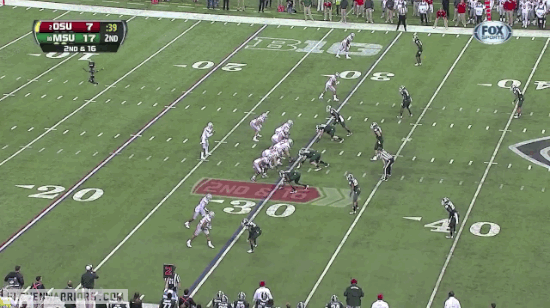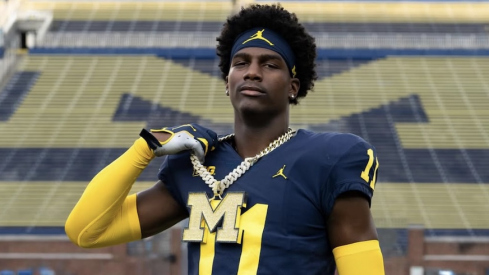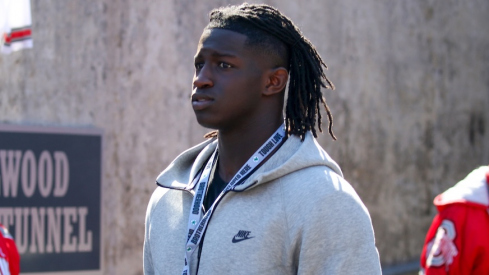
In accepting his second Silver Football award this week, Braxton Miller seemingly criticized how often Urban Meyer and Tom Herman asked him to carry the football. Miller's full quote is not available, but according to the Chicago Tribune's Teddy Greenstein, the number of rushing attempts is influencing Miller's interst in entering the NFL draft.
Miller is wary of exposing himself to the kind of injury he suffered in September, a sprained left knee. He attempted 153 rushes this season (down from 227 last year), averaging 16.5 in the Buckeyes' final four games. He said he's “getting tired” of the pounding and is well aware Ohio State will lose four senior starters on its offensive line.
He wants to develop as more of a traditional, pro-style quarterback, saying: “We recruit running backs. They're on scholarship too.”
Does Miller have a legitimate gripe regarding his use?
Apples to Apples
To analyze, we must distinguish the three ways Miller gets rushing attempts. The first is scrambling. These are not called runs at all, but an outgrowth of the passing game. Miller's scrambling threat enhances his effectiveness as a passer and as a player. It limits the amount of man coverage an opposing defense plays, because by playing men defenders' backs are turned away from the line of scrimmage, providing Miller chunk yardage before the defense reacts. As such, runs on scramble should be included as passing yardage.
Miller demonstrated this against Michigan State. His scrambling versus the Spartans' pattern matching cover 4 led to his biggest runs that day, and allowed Ohio State to claw back into the game.

It goes without saying that the decision to scramble rests with Miller – not Meyer or Herman. And it influences how Miller reacts on passing plays. Miller knows he is a such a good athlete that he holds the football in the pocket, rather than trying to fit throws into tight windows or throw the ball away. Presumably, Miller would continue to scramble with some frequency in an NFL uniform, as it is his ultimate fallback weapon.
Reading is Fundamental
The next chunk of Miller's rushing attempts come on read plays. The amount Miller must run on such plays is a mixed bag. A read play's purpose is to hold one defender with the quarterback run threat, allowing the offense to re-equate numbers and apply better blocking at the point of attack. But a threat does not work unless the offense is willing to act upon it, so a quarterback must be prepared to keep.
That being said, the default on read plays is generally to give, and Miller could lessen his attempts by being more consistent with reads. No quarterback will always make the correct read. And Miller has improved.
But he at times still pre-determines whether to give or keep, particularly with inverted veer. Miller kept on every inverted veer against the Spartans, including a critical third and four, where giving to Jordan Hall likely results in a first down. The Spartan force defender has his shoulders turned towards Miller, and Michigan State has no one left to account for Hall.

Read plays are the foundation of Meyer's offense, so that will not change and Miller will get carries on such plays – though his carries can be limited. But an NFL team that drafted Miller will also presumably utilize the zone read, as NFL coaches have done with other young quarterbacks coming from spread systems. Granted, Miller will be getting paid to run those read plays, but it is hard to imagine an NFL team would utilize Miller as a "traditional, pro-style quarterback" – at least initially.
Dialing Your Number
That brings us to the last source of Miller's rushing attempts, which is designed quarterback runs such as counter trey.

Meyer and Herman are chary with such runs unless and until the Buckeyes are playing a quality opponent such as Michigan State. For instance, Ohio State did not use lead outside zone all season until they faced the Spartans.

But it is no coincidence that Miller's rushing attempts rose in the last month as the passing game became less efficient. Lou Holtz once said that an offense must do two of the following well – run the football, run option, and pass. In other words, you must threaten the defense in multiple ways. So as the Buckeye passing game regressed, Miller's running ability became increasingly important.
That is not to lay the blame for Miller's increased running solely on his passing. Wind, snow, and underwhelming wide receiver play all contributed to a less effective passing game. But blame aside, the Buckeye offense could not succeed with a less than 50% completion rate unless Miller threatened the defense as a runner.
Continuing the Evolution
As Greenstein notes, Miller's carries were reduced from 228 last season to 153 this year, albeit in two less games. And the reduced carries are a reflection of Miller's improvement as a passer. Miller's carries are most directly determined by the number of called designed runs, and such plays are less necessary when the Ohio State offense better threatens the defense with the pass. If Miller continues to make strides as a passer, his number of carries will further fall.
But Miller's rushing attempts are likely a side note to whether Miller opts for the draft. Miller would undoubtedly be featured in a more pass happy offense next season, but his comments indicate he wants to leave for the NFL if he receives back a draft evaluation to his liking. Only Miller can say what grade he needs to hear to leave, but if he received a first or perhaps even second round evaluation it would be difficult to blame him for leaving early.

